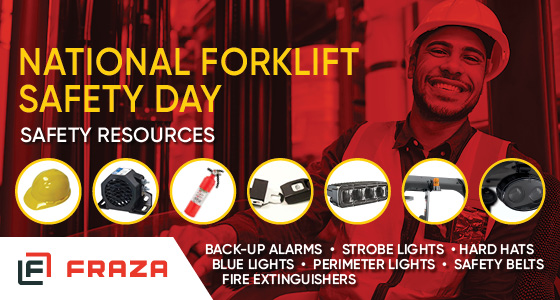
The Latest
Avoid Hazards with These Forklift Safety Tips

Forklift safety is important for the wellbeing of operators and pedestrians. While common sense is a must while you are actively using or spending time in a warehouse with heavy machinery and heavy equipment, a lot of forklift safety best practices may not come naturally. Luckily for you, we have compiled all of our best tips here so you can stay safe in the workplace. Keep reading so you can take our quiz and win a prize!
Forklift Safety Features You Need
Every forklift comes equipped with standard safety features that protect the driver while in operation. Safety features like seatbelts and reverse alarms are standard on every forklift, but there are options for add-ons to increase your efficiency and safety.
Standard Forklift Safety Features
Every forklift comes equipped with standard safety features that protect the driver while in operation. One of the most important standard safety features is the seatbelt. Another important standard safety feature on forklifts is the reverse alarm. Visibility is important not only to operators, but to pedestrians as well. While an operator is traveling in reverse, their visibility is limited. The reverse alarm makes it easier for drivers to let pedestrians and other operators know that they are backing up and to remain a safe distance away from the forklift.
Additional Safeguards
While a putting on a seatbelt feels like second nature to most, some operators fail to do so. Switching out the standard seatbelt for an orange belt will make the seatbelt more visible and hold operators accountable. In addition to the reverse alarm on your truck, lights are another option to increase safety. If the workplace is too loud, pedestrians and operators won’t be able to hear the alarm while the operator is backing up. Trucks are already equipped with standard safety lights, but blue safety lights can be added to increase visibility to pedestrians. Blue lights can be placed in front of or on the rear of the forklift and shine on the floor to alert others that a forklift is approaching. Check out our forklift safety features blog post here.
Forklift Fork Inspection and Safety
When is the last time you inspected your forklifts’ forks? Keeping them in optimal shape is essential to the safe and efficient operation of your forklift fleet.
Forks are one of the most used items on a forklift and businesses are often not aware of their forks’ condition or quality. This useful forklift fork inspection guide will help you avoid pitfalls once you begin ramping up production. Check out our forklift fork inspection and safety blog post here.
Forklift Operator Safety Tips
Safe Driving Tips
According to the Occupational Safety and Health Association (OSHA), approximately 70 percent of all forklift incidents in the United States could be avoided with proper safety training and policy. While these blog posts won’t take the place of in-person training and certification, they cover some of the most important safety precautions you can take as an operator. Check out our safe driving tips blog post here.
Driving with Forks
When driving a forklift, it’s important to keep the forks at a safe height off the ground. MI-OSHA recommends keeping them between 2 – 4 inches and tilted slightly back. This height reduces the potential for seriously injuring any pedestrians in the upper leg or torso. Also, always remember to activate the horn when heading towards people so that they hear you coming. Check out our driving with forks blog post here.
Parking with Forks
Forks should always be in the tilted downward position when parked. The best way to achieve this is for the operator to tilt them forward before lowering them to the ground. Lowering to the ground then tilting forward puts stress on the mast pulleys and hoses when raised by the next driver. This can cause damage to your forklift over time. Check out our parking with forks blog post here.
View our forklift operator safety video playlist below.
Warehouse Pedestrian Safety Tips
While not all of us in the material handling industry are forklift operators, we are all pedestrians in a warehouse at one time or another, and it’s important for us to pay close attention to our surroundings at all times to ensure that we and others are always safe. To view all our tips for staying safe in the warehouse as a pedestrian, check out our blog post here.
View our warehouse pedestrian safety video playlist below.
Now that you know all our best tips for staying safe, whether you’re a forklift operator or a pedestrian in a warehouse or facility where forklifts are being used, it’s time to test your knowledge! Click the button below to take our survey and win a prize.